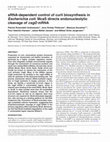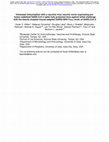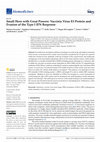Papers by Mateusz Szczerba
Biomedicines, Jan 22, 2022
This article is an open access article distributed under the terms and conditions of the Creative... more This article is an open access article distributed under the terms and conditions of the Creative Commons Attribution (CC BY

Nucleic Acids Research, Jun 14, 2018
Production of curli, extracellular protein structures important for Escherichia coli biofilm form... more Production of curli, extracellular protein structures important for Escherichia coli biofilm formation, is governed by a highly complex regulatory mechanism that integrates multiple environmental signals through the involvement of numerous proteins and small non-coding RNAs (sRNAs). No less than seven sRNAs (McaS, RprA, GcvB, RydC, RybB, OmrA and OmrB) are known to repress the expression of the curli activator CsgD. Many of the sRNAs repress CsgD production by binding to the csgD mRNA at sites far upstream of the ribosomal binding site. The precise mechanism behind sRNA-mediated regulation of CsgD synthesis is largely unknown. In this study, we identify a conserved A/U-rich region in the csgD mRNA 5 untranslated region, which is cleaved upon binding of the small RNAs, McaS, RprA or GcvB, to sites located more than 30 nucleotides downstream. Mutational analysis shows that the A/U-rich region as well as an adjacent stem-loop structure are required for McaS-stimulated degradation, also serving as a binding platform for the RNA chaperone Hfq. Prevention of McaS-activated cleavage completely relieves repression, suggesting that endoribonucleolytic cleavage of csgD mRNA is the primary regulatory effect exerted by McaS. Moreover, we find that McaS-mediated degradation of the csgD 5 untranslated region requires RNase E.
Methods in molecular biology, Oct 28, 2020
Necroptosis has been implicated as a critical cell death pathway in cancers, Alzheimer’s and othe... more Necroptosis has been implicated as a critical cell death pathway in cancers, Alzheimer’s and other neurodegenerative diseases, and virus-infected cells. Necroptosis occurs when mixed-lineage kinase domain-like protein (MLKL) punctures the cytoplasmic membrane allowing a rapid influx of water leading to a loss of cellular integrity. As its role in human disease becomes apparent, methods identifying necroptosis will need to be further developed and optimized. Here we describe identification of necroptosis through quantifying cell death with pathway inhibitors and using western blots to identify end points of MLKL activation and protein-protein interactions leading to it.
Science Signaling, Mar 14, 2023
Cellular stress granules arise in cells subjected to stress and promote cell survival. A cellular... more Cellular stress granules arise in cells subjected to stress and promote cell survival. A cellular protein that localizes to stress granules is Z-DNA–binding protein 1 (ZBP1), which plays a major role in necroptosis, a programmed cell death pathway mediated by the kinase RIPK3. Here, we showed that the stress granule inducer arsenite activated RIPK3-dependent necroptosis. This pathway required ZBP1, which localized to arsenite-induced stress granules. RIPK3 localized to stress granules in the presence of ZBP1, leading to the formation of ZBP1-RIPK3 necrosomes, phosphorylation of the RIPK3 effector MLKL, and execution of necroptosis. Cells that did not form stress granules did not induce necroptosis in response to arsenite. Together, these results show that arsenite induces ZBP1-mediated necroptosis in a manner dependent on stress granule formation.

bioRxiv (Cold Spring Harbor Laboratory), Dec 8, 2021
The Omicron SARS-CoV-2 variant has been designated a variant of concern because its spike protein... more The Omicron SARS-CoV-2 variant has been designated a variant of concern because its spike protein is heavily mutated. In particular, Omicron spike is mutated at 5 positions (K417, N440, E484, Q493 and N501) that have been associated with escape from neutralizing antibodies induced by either infection with or immunization against the early Washington strain of SARS-CoV-2. The mouse-adapted strain of SARS-CoV-2, SARS2-N501YMA30, contains a spike that is also heavily mutated, with mutations at 4 of the 5 positions in Omicron spike associated with neutralizing antibody escape (K417, E484, Q493 and N501). In this manuscript we show that intranasal immunization with a pre-fusion stabilized Washington strain spike, expressed from a highly attenuated, replication-competent vaccinia virus construct, NYVAC-KC, fully protected mice against disease and death from SARS2-N501YMA30. Similarly, immunization by scarification on the skin fully protected against death, but not from mild disease. This data demonstrates that Washington strain spike, when expressed from a highly attenuated, replicationcompetent poxvirus, administered without parenteral injection can fully protect against the heavily mutated mouse-adapted SARS2-N501YMA30.
Science Signaling
Cellular stress granules arise in cells subjected to stress and promote cell survival. A cellular... more Cellular stress granules arise in cells subjected to stress and promote cell survival. A cellular protein that localizes to stress granules is Z-DNA–binding protein 1 (ZBP1), which plays a major role in necroptosis, a programmed cell death pathway mediated by the kinase RIPK3. Here, we showed that the stress granule inducer arsenite activated RIPK3-dependent necroptosis. This pathway required ZBP1, which localized to arsenite-induced stress granules. RIPK3 localized to stress granules in the presence of ZBP1, leading to the formation of ZBP1-RIPK3 necrosomes, phosphorylation of the RIPK3 effector MLKL, and execution of necroptosis. Cells that did not form stress granules did not induce necroptosis in response to arsenite. Together, these results show that arsenite induces ZBP1-mediated necroptosis in a manner dependent on stress granule formation.
Necroptosis has been implicated as a critical cell death pathway in cancers, Alzheimer's and ... more Necroptosis has been implicated as a critical cell death pathway in cancers, Alzheimer's and other neurodegenerative diseases, and virus-infected cells. Necroptosis occurs when mixed-lineage kinase domain-like protein (MLKL) punctures the cytoplasmic membrane allowing a rapid influx of water leading to a loss of cellular integrity. As its role in human disease becomes apparent, methods identifying necroptosis will need to be further developed and optimized. Here we describe identification of necroptosis through quantifying cell death with pathway inhibitors and using western blots to identify end points of MLKL activation and protein-protein interactions leading to it.

Nucleic Acids Research, 2018
Production of curli, extracellular protein structures important for Escherichia coli biofilm form... more Production of curli, extracellular protein structures important for Escherichia coli biofilm formation, is governed by a highly complex regulatory mechanism that integrates multiple environmental signals through the involvement of numerous proteins and small non-coding RNAs (sRNAs). No less than seven sRNAs (McaS, RprA, GcvB, RydC, RybB, OmrA and OmrB) are known to repress the expression of the curli activator CsgD. Many of the sRNAs repress CsgD production by binding to the csgD mRNA at sites far upstream of the ribosomal binding site. The precise mechanism behind sRNA-mediated regulation of CsgD synthesis is largely unknown. In this study, we identify a conserved A/U-rich region in the csgD mRNA 5 untranslated region, which is cleaved upon binding of the small RNAs, McaS, RprA or GcvB, to sites located more than 30 nucleotides downstream. Mutational analysis shows that the A/U-rich region as well as an adjacent stem-loop structure are required for McaS-stimulated degradation, also serving as a binding platform for the RNA chaperone Hfq. Prevention of McaS-activated cleavage completely relieves repression, suggesting that endoribonucleolytic cleavage of csgD mRNA is the primary regulatory effect exerted by McaS. Moreover, we find that McaS-mediated degradation of the csgD 5 untranslated region requires RNase E.

Biomedicines
Poxviridae have developed a plethora of strategies to evade innate and adaptive immunity. In this... more Poxviridae have developed a plethora of strategies to evade innate and adaptive immunity. In this review, we focused on the vaccinia virus E3 protein, encoded by the E3L gene. E3 is present within the Chordopoxvirinae subfamily (with the exception of the avipoxviruses and molluscum contagiosum virus) and displays pleiotropic effects on the innate immune system. Initial studies identified E3 as a double-stranded RNA (dsRNA)-binding protein (through its C terminus), able to inhibit the activation of protein kinase dependent on RNA (PKR) and the 2′5′-oligoadenylate synthetase (OAS)/RNase L pathway, rendering E3 a protein counteracting the type I interferon (IFN) system. In recent years, N-terminal mutants of E3 unable to bind to Z-form nucleic acids have been shown to induce the cellular death pathway necroptosis. This pathway was dependent on host IFN-inducible Z-DNA-binding protein 1 (ZBP1); full-length E3 is able to inhibit ZBP1-mediated necroptosis. Binding to what was identified a...

The Omicron SARS-CoV-2 variant has been designated a variant of concern because its spike protein... more The Omicron SARS-CoV-2 variant has been designated a variant of concern because its spike protein is heavily mutated. In particular, Omicron spike is mutated at 5 positions (K417, N440, E484, Q493 and N501) that have been associated with escape from neutralizing antibodies induced by either infection with or immunization against the early Washington strain of SARS-CoV-2. The mouse-adapted strain of SARS-CoV-2, SARS2-N501YMA30, contains a spike that is also heavily mutated, with mutations at 4 of the 5 positions in Omicron spike associated with neutralizing antibody escape (K417, E484, Q493 and N501). In this manuscript we show that intranasal immunization with a pre-fusion stabilized Washington strain spike, expressed from a highly attenuated, replication-competent vaccinia virus construct, NYVAC-KC, fully protected mice against disease and death from SARS2-N501YMA30. Similarly, immunization by scarification on the skin fully protected against death, but not from mild disease. This ...

Uploads
Papers by Mateusz Szczerba